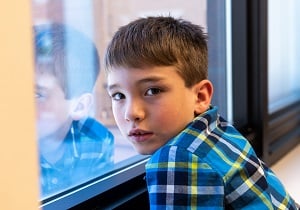Dravet Syndrome: Sebastian's Story
Sebastian is an energetic, happy 8-year-old who loves climbing, dogs, green vegetables and the American flag.

Sebastian has Dravet Syndrome, a rare form of epilepsy with multiple, lifelong impacts. Sebastian had his first seizure at 6 months, but it was several frustrating years before his parents, Scott and Marisa, discovered his Dravet diagnosis with the help of Children’s Mercy Kansas City’s Neurology Department, Comprehensive Epilepsy Center and Genetics Clinic.
Because of his condition, Sebastian has frequent seizures with alterations in body temperature. His parents think his first seizure was caused by a post-vaccination fever. At the time, ER physicians also thought the seizure was febrile and not a sign of a disorder. Unfortunately, Sebastian’s seizures kept coming. In the first two years of his life, Sebastian experienced weekly seizures, each lasting up to 20 minutes.
As Sebastian’s seizures lengthened and didn’t seem to respond to medication, Scott and Marisa researched Dravet Syndrome and requested genetic testing at Children’s Mercy. Sure enough, like 80% of patients with Dravet Syndrome, Sebastian has an SCN1A gene mutation that is linked to seizures, developmental delays and other symptoms. This knowledge helped Sebastian’s family and his doctors begin to fine-tune his treatment, a process that takes time, patience, and a lot of trial and error.
“Over these years, every time the phone rang, I’d have a panic attack, because I thought it’s somebody calling me to say Sebastian’s having a seizure” Scott said. It got to the point where EMTs would ask Scott and Marisa if they had medical backgrounds because they were so knowledgeable about seizure protocols and treatments. They looked into every therapy that could possibly help Sebastian, including cannabidiol (CBD), a popular alternative for families dealing with Dravet Syndrome.
Finding their perfect provider match
In 2017, they began working with Lalit Bansal, MD, Director of the Epilepsy Surgery Program and head of the Comprehensive Dravet Syndrome Clinic at Children’s Mercy. The clinic coordinates access to all specialties relevant to the syndrome, including epilepsy, sleep medicine, clinical genetics, gastroenterology, developmental and behavioral health, nutrition, neuropharmacology and social work.
“He was very open minded,” Scott said of Dr. Bansal, who helped Sebastian’s family safely integrate CBD into his treatment while they waited for the first FDA-approved cannabidiol, Epidiolex, to come to market. (It is now available in the United States and part of Sebastian’s drug regimen.)
“He’s been our doctor ever since,” Scott said. “He’s had great advice, and he’s always asking about Sebastian’s progress. He’s just a great man.”
In early 2021, Dr. Bansal implanted a Vagus Nerve Stimulation (VNS) device in Sebastian’s chest to help regulate his seizures.
“Vagus nerve stimulation is a minimally invasive, non-resective, palliative treatment for kids with epilepsy who have failed two or more seizure medications,” Dr. Bansal explained.
VNS uses electrical impulses to trigger the vagus nerve, which regulates a variety of sensory and motor functions in the body. VNS can stop seizures from starting and help shorten them if they do. When a seizure occurs, the patient’s caregivers swipe a hand-held magnet over the chest to kick-start the device and interrupt the seizure. VNS reduces the need for rescue medications, decreases post-seizure symptoms like confusion and tiredness, and has minimal side effects. Its effectiveness increases with time.
“We have large experience with VNS and know how to get the maximum benefit out of it,” Dr. Bansal said. Patients at Children’s Mercy tend to have higher VNS success rates than the national average, which are already promising: Some patients become seizure-free while many have significant reductions in seizures.
So far, VNS has decreased both the length and number of Sebastian’s seizures. “The seizures are now less than a minute and usually stop before we even get to the magnet,” Scott said. “He’s doing well.”
Support and steps forward
In addition to Dr. Bansal and his parents, Sebastian’s team includes supportive school staff and his little brother and best buddy, Malcom. Scott and Marisa have found their own encouragement through in-person and online connections with other parents of children with epilepsy.
“It helps to hear that everybody else is having the same issues,” said Scott. “It’s a scary condition, especially when you’re first starting out.”
Sebastian and his family are currently working on his verbal development. “He’s really smart; he just can’t communicate very well,” Scott said. They are building those skills as they help Sebastian navigate the world with Dravet Syndrome.
One of Sebastian’s best traits — enthusiasm — can also put him at risk. He will run straight toward his favorite things, including any and all American flags. His family began stocking miniature flags in bulk to help keep Sebastian’s interest at home; he liked to race out of the house to investigate the neighbors’ flags. “We’ve had a lot of practice learning to deal with his fearlessness,” said Scott.
Sebastian and his family will continue to visit the Comprehensive Dravet Syndrome Clinic at Children’s Mercy quarterly to monitor his progress and address challenges as they arise.
"The goal is to improve his quality of life in whichever way we can,” said Dr. Bansal. “We just love him and love to have him in the clinic.”